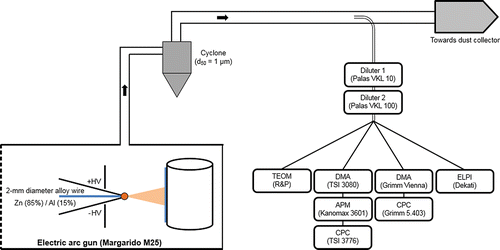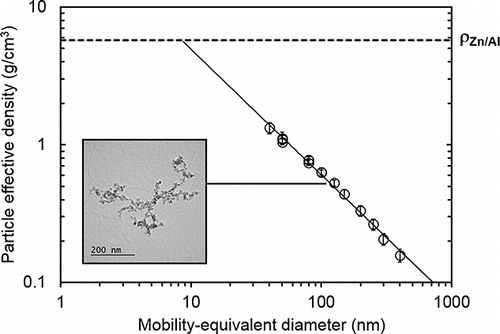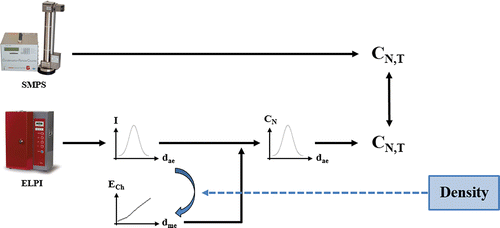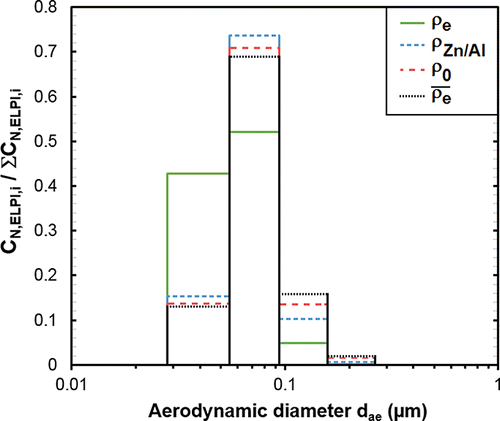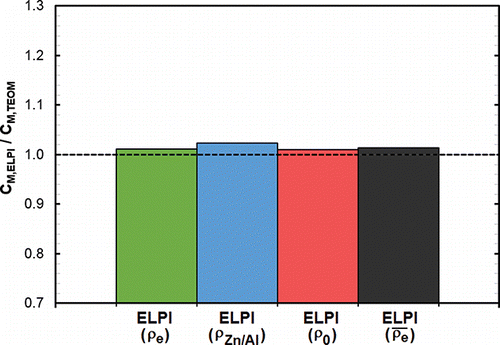Abstract
This study compared number and mass concentrations obtained using two reference devices, a scanning mobility particle sizer (SMPS) and a tapered element oscillating microbalance (TEOM), with those calculated from raw electrical low-pressure impactor (ELPI) data. ELPI data post-treatment was performed assuming a mobility-dependent effective density and three constant densities: an average effective density, the raw material density, and the standard density (i.e., 1 g/cm3). For the mass concentration, whatever the density considered, the ELPI-determined value was close to the reference. For the number concentration, results indicate good agreement between SMPS and ELPI number concentrations when considering effective density and, to a lesser extent, average effective density. In contrast, with the raw material density or standard density, large uncertainties in number concentration measurements were produced. A good estimation of number concentration was obtained based on ELPI data when assuming a standard density only when there was fortuitous agreement between the number tested aerosol size distribution and its mobility-dependent effective density. Thus, contrary to what some authors recommend, a standard density cannot be universally used.
Copyright © 2015 American Association for Aerosol Research
1. INTRODUCTION
Airborne particle number size distribution is among the key characteristics used to assess occupational exposure and atmospheric, engine, or indoor air emissions. Various devices are classically implemented to measure airborne particle number size distribution (aerodynamic particle sizer, scanning mobility particle sizer, fast mobility particle sizer) as part of online workplace and/or environmental aerosol characterization. Among them, the electrical low-pressure impactor (ELPI), developed by Keskinen et al. Citation(1992), can measure number size concentrations in real-time over a wide particle size range (from 30 nm to 10 µm). Moreover, as particles are collected on impaction plates, subsequent physical/chemical analysis of the aerosol can be performed. However, this multijet cascade impactor has a limited size resolution (only 12 channels), and like in any cascade impactor, particles of same size may deposit on multiple stages (Dong et al. Citation2004), be lost (Virtanen et al. Citation2001), or bounce (Kuuluvainen et al. Citation2013). Several mechanisms contribute to the deposition of particles in the ELPI (Marjamäki et al. Citation2005).
In the ELPI, particles are first charged according to their mobility-equivalent diameter and then separated (by inertia) according to their aerodynamic equivalent diameter. When electrically-charged particles are deposited on the insulated impaction stages in the ELPI (based on their aerodynamic equivalent diameter), an electrical current is generated. The number concentration in each channel can then be calculated by applying a charging law dependent on mobility-equivalent diameter, itself related to the aerodynamic diameter. The use of these two particle diameter concepts requires the knowledge of density to convert one into the other. Consequently, an assumption must be made about particle density when seeking to determine the particle number size distribution based on the particle aerodynamic diameter. It is also possible to calculate the corresponding mass concentration from ELPI data, using a formula also requiring a particle density. The density to use depends somewhat on the nature and the morphology of the aerosol. Thereby, for non-porous spherical particles, the material density can be used, but with agglomerates defining the density is more complex. In this article, the concept of effective density, defined as the ratio of agglomerate mass to equivalent-mobility volume, will be used.
Several intercomparison studies have already been performed, in which data produced by an ELPI were compared to those produced by instruments based on different measurement principles (Pagels et al. Citation2005; Nabi et al. Citation2012). In most of these articles, the authors did not specify the density value implemented in the ELPI software, or else the value was specifically adjusted to produce an overlap between the number size distributions measured by different instruments (Price et al. Citation2014). Other authors have recommended using an arbitrary value for the density. Thus, Arffman et al. Citation(2014) mentioned that the size distribution measured by the ELPI can be calculated assuming unit density when the aerosol has not been fully characterized. Similarly, Held et al. Citation(2008) considered a density of 1.5 g/cm3–a typical value for ambient particle density (Zhang et al. Citation2004)—when characterizing atmospheric aerosols.
A number of studies investigating how best to convert ELPI particle number distributions into mass distributions have been reviewed by Liang et al. Citation(2013). From this analysis, it emerges that in previous studies with ELPI and SMPS mass measurements, two types of density were assumed. A constant density was assumed by some authors (Shi et al. Citation1999; Ushakov et al. Citation2013). Andrews et al. Citation(2001) described how this assumption can result in extensive uncertainties in mass measurements and consequently recommended using the effective density when calculating the mass concentration from the number concentration. A limitation to the studies cited is that they only investigated how density affected the conversion of number into mass concentration, and not the conversion of ELPI current (raw data) into number concentration.
The aim of this article is to compare ELPI data to number and mass concentrations obtained using two reference devices, a scanning mobility particle sizer (SMPS) and a tapered element oscillating microbalance (TEOM). Specific attention was paid to how particle density can be used to improve ELPI data post-treatment.
2. MATERIALS AND METHODS
2.1. Experimental Setup and Particle Characterization
Tested aerosols were Zn/Al agglomerates generated by thermal metal spraying (Bémer et al. Citation2010). The experimental setup, shown in , was composed of an electric arc gun (Margarido M25) supplied with a 2-mm diameter Zn/Al (85-15%) alloy wire. The thermal spraying process was automated and spray was directed onto a rotating metal cylinder (D = 40 cm, H = 40 cm). The electric arc gun was equipped with a moving arm describing a vertical translation so that deposition would be uniform throughout several hours of operation. The aerosol generated by the thermal spraying process was extracted in a 20-cm diameter duct and directed to a cyclone (1-µm cutoff aerodynamic diameter) with an air-flow rate close to 2000 m3/h. The cyclone was placed upstream of the characterization part of the setup.
Various real-time devices were placed downstream of two Palas VKL (10 and 100) dilutors and a splitter (TSI, model 3708): a TEOM to measure total mass concentrations; a SMPS (DMA Grimm, Vienna type + CPC Grimm model 5.403) to determine particle number size distribution based on mobility-equivalent diameter, and an ELPI (Dekati) to determine particle number size distribution based on aerodynamic diameter. Grease has been applied on ELPI impaction surfaces in order to reduce the particle bounce and reentrainment. (Rao and Whitby Citation1978). Moreover, a high dilution rate and a short sampling time have been used in order to avoid an overloading and the formation of piles on the ELPI stages (Van Gulijk et al. Citation2001). Indeed, a long-term collection on an ELPI induces the formation of domes on the stages and the measurement of biased number size distributions (Garra et al. Citation2016).
In addition, a differential mobility analyzer (DMA TSI, model 3080), an aerosol particle mass analyzer (APM Kanomax, model 3601), and a Condensation Particle Counter (CPC TSI, model 3776) were added to determine particle mass and effective density. Further details on the protocol used and on other approaches to determine particle effective density can be found in Charvet et al. Citation(2014).
This protocol allowed us to determine how the effective density of an agglomerate changed with its mobility-equivalent diameter (. As expected, the results highlight a much lower effective density for agglomerates than for the raw material. The relationship between effective density (ρe expressed in g/cm3) and mobility diameter (dme expressed in nm) was determined using the least squares method for a particle size range from 40 to 400 nm:
As in Charvet et al. Citation(2014), the diameter of the primary particles composing the aggregates was obtained by extrapolation and found to be 8.6 nm. This diameter agrees well with the diameters measured on TEM micrographs, where an average primary particle diameter of 9.1 nm was obtained based on about a hundred primary particles (Bémer et al. Citation2013). The mass-mobility exponent of these Zn/Al agglomerates was close to 2.1, which is in line with results presented by Sorensen Citation(2011) in his review of diffusion-limited cluster aggregation (DLCA) aggregates in the slip flow regime.
2.2. Data Processing Methods
Number and mass concentrations obtained from the SMPS and the TEOM, respectively, were compared to the concentrations calculated from the ELPI data (with particle loss correction). ELPI data post-treatment was performed assuming different particle densities:
| • | the mobility-dependent effective density determined by the tandem DMA/APM (EquationEquation (1)) | ||||
| • | the density of the raw material (ρZn/Al = 5.72 g/cm3); | ||||
| • | the standard density (ρ0 = 1 g/cm3); | ||||
| • | an average effective density (defined by EquationEquation (2) | ||||
2.2.1. Comparison of Number Concentration Data
Number concentrations obtained with the SMPS can be compared to calculated concentrations determined based on ELPI data (). As considered particles were agglomerates, the SMPS number size distribution was corrected for variations in charging efficiency in line with Lall and Friedlander Citation(2006). As stated in the Introduction, ELPI raw data corresponds to electrical currents measured for each stage, and each stage is defined by its cutoff aerodynamic diameter. Converting this current distribution into number size distribution involves: (1) conversion of the aerodynamic diameters into mobility-equivalent diameters:
Finally, the total number concentration can be determined using:[5]
Consequently, as stated in EquationEquation (3)[3] , the density of the particles considered needs to be known or estimated.
2.2.2. Comparison of Mass Concentration Data
The overall mass concentration obtained with the TEOM can be compared to a concentration calculated based on ELPI data (). As when calculating the number concentration, the ELPI geometrical midpoint diameters expressed in terms of aerodynamic diameters must be converted into mobility diameters to determine the particle number concentration for each stage, based on electrical currents (EquationEquation (5)[5] ). A particle density is once again required to convert this number concentration into a mass concentration (EquationEquation (6)
[6] ):
3. EXPERIMENTAL RESULTS
3.1. Raw Data
The experimental current distribution measured on each stage of the ELPI according to particle aerodynamic diameters is presented in (left). Only stages 1–8 of the ELPI (range of aerodynamic diameters from 0.03 µm to 1.61 µm) were considered in this study because the slightest current on stages with dae > 1.61 µm causes significant overestimation of the mass concentration (Maricq et al. Citation2006; Zervas et al. Citation2006). Over 99.9% of the total current was measured on the eight stages considered, i.e., more than 99.997% of the total number concentration (whatever the assumed density). As further evidence of the full relevance of these eight stages, stages 9–12 presented currents lower than 10 fA, which corresponds to the electrometer's experimental limit of quantification.
FIG. 5. Characterization of Zn/Al agglomerates generated by thermal metal spraying: ELPI current distribution (left) and SMPS number size distribution with lognormal fitted curve (right).
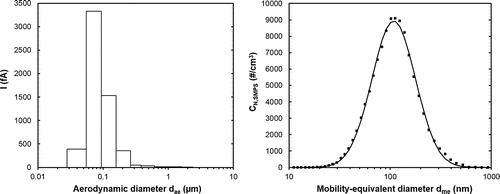
The number size distribution measured by the SMPS is also presented in (right). This distribution was fitted by a lognormal model by applying the least squares method, and indicated a count median diameter of 108 nm and a Geometric Standard Deviation (GSD) of 1.6.
3.2. Comparison of Number Concentrations
The relative number concentrations obtained from ELPI data using the four different densities in data processing methods described above are presented in . Total number concentrations are given in . For all relative number size distributions, stage 2 (0.055 – 0.094 µm) corresponds to the largest particle number concentration, representing between roughly 50% and 75% of the total concentration. also shows that using the effective density leads to a greater particle number fraction on the first stage of the ELPI. Using this density may cause the appearance of a tail to the left of the number size distribution (dae < 0.03 µm). This tail cannot be quantified and thus could cause an underestimation of the total number concentration.
TABLE 1 ELPI number and mass concentrations as a function of the density considered
The total number concentrations calculated using ELPI raw data were compared to the total concentration measured with the SMPS, which was 1.03 × 108 #/cm3 ().
From , calculations based on the raw material density, as expected, overestimated the number concentration: the overestimation was considerable in our study, with an increase by a factor close to 30. In contrast, calculations based on the effective density (ratio equal to 0.95), and to a lesser extent, based on the average effective density (ratio equal to 0.89), agreed well with SMPS measurements. Interestingly, calculations involving a standard density only overestimated the number concentration by a factor of 1.5. Thus, based on these results, computing an ELPI number concentration by applying the standard density could be a relevant choice.
3.3. Comparison of Mass Concentrations
ELPI mass concentrations were calculated for four different densities by applying the previously described methodology. More precisely, the relative mass size distribution () and the total mass concentrations () were compared to the total TEOM reference concentration. In our experiments, the TEOM concentration was found to equal 71.58 mg/m3. The mobility-dependent effective density was also used to convert the SMPS number concentration into a mass concentration, resulting in a value of 65.93 mg/m3, which is quite close to the TEOM concentration.
FIG. 8. ELPI relative mass size distributions as a function of aerodynamic diameter and chosen density.
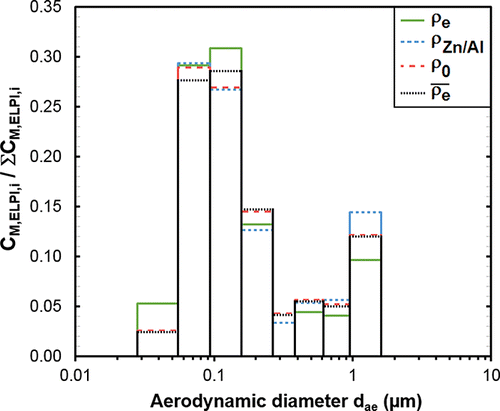
shows the mass size distributions calculated using the different particle densities, all of which are quite similar with a first mode around 0.1 µm representing more than 50% of the total mass concentration. Moreover, for all relative mass size distributions, a second mode was observed on stage 8 (0.95–1.61 µm), representing roughly between 10% and 15% of the total mass concentration.
The ratio between the mass concentrations obtained by the TEOM and those calculated from ELPI data show good agreement for all the densities tested. For this post-treatment, the density was used twice in calculations. Consequently, if the number concentration was overestimated through the use of an inappropriate density, the effect could be compensated for during the conversion of the ELPI particle number distributions into mass distributions.
4. CAN STANDARD DENSITY BE UNIVERSALLY APPLIED?
This article examined how well number and mass concentrations calculated from ELPI data agreed with the same concentrations measured using two reference devices. The results presented in suggest that computing an ELPI number concentration by applying the standard density could be a relevant choice. Is this experimental agreement a fortuitous combination of the Zn/Al aerosol size distribution and its effective density (which results in average effective density close to unity)? Would this agreement be observed for another particle size distribution? Is the standard density really a universal choice in ELPI data post-treatment?
To resolve these questions, we further analyzed how the standard density affected number concentration for a theoretical lognormal particle size distribution (expressed as a function of a mobility-equivalent diameter). The simulated particle number size distributions presented median diameters of 50, 100, 200, or 300 nm with identical GSDs of 1.6. These theoretical aerosols were injected at the ELPI inlet, and the resulting theoretical currents on each ELPI stage were calculated using the method described by Bau et al. Citation(2014). The corresponding number and mass concentrations (CN,ELPI and CM,ELPI, respectively) were then determined by assuming a constant particle density. The ratios between the theoretical ELPI number concentration and the reference total number concentration, calculated from the simulated particle number size distributions, are presented in (left axis) for different values of particle density; as it is done for the mass ratios (, right axis). The mobility-dependent effective density (EquationEquation (1))[1] was used to convert the reference number concentrations into mass concentrations.
FIG. 10. Theoretical concentration ratios as a function of density and particle size distribution (solid and empty symbols represent experimental results in terms of mass and number, respectively).
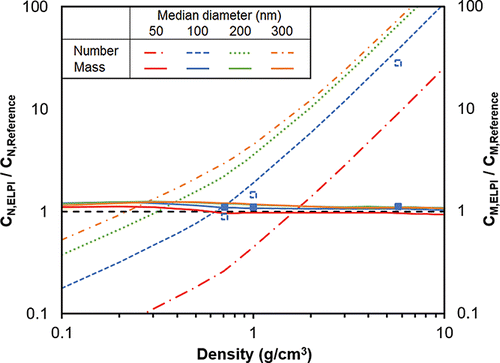
In , the horizontal dashed line represents a mass concentration ratio and a number concentration ratio equal to 1. Data for mass concentrations obtained for all median diameters fall within 20% of this line. Because the count median diameter of Zn/Al airborne particles determined from their number size distribution was very close to 100 nm (), some experimental results are also represented in . Thus, for a particle number size distribution centered at 100 nm, very good agreement was observed between experimental and theoretical results, both for mass and number concentrations. In contrast, when the distribution was centered at 200 or 300 nm and a unit standard density was considered, the number concentration was overestimated compared to the SMPS value by a factor of 3.6 and 4.5, respectively, while for a distribution centered at 50 nm, the number concentration was underestimated by a factor of 2.2 ().
TABLE 2 Ratio between ELPI and reference number concentrations according to particle density
Thereby, the good agreement obtained between ELPI and reference experimental number concentrations (for a particle number size distribution centered at approximatively 100 nm) was due to a fortuitous combination of the Zn/Al aerosol size distribution and its effective density. These results suggest that the standard density cannot be used as a universal approach in calculations as it induces a strong discrepancy in the number concentrations calculated from ELPI data. We would expect ratios in the same order of magnitude for other types of aerosols and different particle size distributions.
Thus, it appears essential to have access to the effective density of an aerosol to ensure that a reliable number concentration can be provided based on ELPI data. In terms of practicality, a constant density was more convenient to use in ELPI software than the fluctuating mobility-dependent effective density. In addition, even though it still involves the use of a constant value in ELPI data post-treatment, it makes sense to choose the average effective density (if known) rather than the standard density. Indeed, the average effective density was closer to the optimal density (defined as the density to use to obtain a number concentration ratio equal to 1, see ) for all the theoretical particle number size distributions considered here.
5. CONCLUSION
Among the key characteristics of agglomerates, density plays an important role in the data reduction of most of metrological devices and in the relationship between number distributions and mass distributions (Mc Murry et al. Citation2002). In this study, the number and mass concentrations obtained by two reference devices (an SMPS and a TEOM) were compared to those calculated from raw ELPI data. ELPI data post-treatment was performed assuming different particle densities. The results showed that if aerosols are perfectly characterized, good measurements of mass and number concentrations can be obtained with an ELPI by using the raw material density for spherical particles and the effective density for agglomerates. In the latter case, additional raw data post-treatment are required.
If aerosols are not fully characterized (i.e., if the effective density is unknown), a constant density should be used, but the number concentrations provided by the ELPI may not be reliable. In particular, the standard density should not be considered as a universal choice. Indeed, depending on the particle size distribution, using the standard density could lead to incorrect or fortuitously correct results.
An approach consisting in using (even an erroneous) constant density twice (to convert currents into particle number concentration and then number concentration into mass concentration) provides an adequate estimation of the mass concentration, within roughly ±20%, whatever the particle size distribution and density. This approach is recommended rather than (1) using the standard density in ELPI software for conversion of currents into particle number concentration and (2) using the mobility-dependent effective density to convert the number concentration into a mass concentration.
REFERENCES
- Andrews, G. E., Clark, A. G., Rojas, N. Y., Sale, T., and Gregory, D. (2001). Diesel Particle Size Distribution: The Conversion of Particle Number Size Distribution to Mass Distribution. SAE Technical Paper, 2001-01-1946.
- Arffman, A., YLi-Ojanperä, J., Kalliokoski, J., Harra, J., Pirjola, L., Karjalianen, P., Rönkkö, T., and Keskinen J. (2014). High-Resolution Low-Pressure Cascade Impactor. J. Aerosol Sci., 78:97–109.
- Bau, S., Bémer, D., Grippari, F., Appert-Collin, J. C., and Thomas, D. (2014). Determining the Effective Density of Airborne Nanoparticles Using Multiple Charging Correction in a Tandem DMA/ELPI Setup. J. Nanopart. Res., 16:2629.
- Bémer, D., Régnier, R., Subra, I., Sutter, B., Lecler, M. T., and Morele, Y. (2010). Ultrafine Particles Emitted by Flame and Electric Arc Guns for Thermal Spraying of Metals. Ann Occup Hyg., 54:607–614.
- Bémer, D., Subra, I., Morele, Y., Charvet A., and Thomas, D. (2013). Experimental Study of Granular Bed Filtration of Ultrafine Particles Emitted by a Thermal Spraying Process. J. Aerosol Sci., 63:25–37
- Charvet, A., Bau, S., Bémer, D., and Thomas, D. (2014). Characterizing the Effective Density and Primary Particle Diameter of Airborne Nanoparticles Produced by Spark Discharge Using Mobility and Mass Measurements (Tandem DMA/APM). J. Nanopart. Res., 16:2418.
- Dong, Y., Hays, M. D., Smith, N. D., and Kinsey, J. S. (2004). Inverting Cascade Impactor Data for Size-Resolved Characterization of Fine Particulate Source Emissions. J. Aerosol Sci., 35:1497–1512.
- Garra, P., Trouvé, G., Dieterlen, A., and Kohler, S. (2016). Impactors Long Term Collection Errors and Correction Using Reflected Light Microscopy. J. Aerosol Sci., 91:1–14.
- Held, A., Zerrath, A., McKeon, U., Fehrebach, T., Niessner, R., Plass-Dülmer, C., Kaminski, U., Berresheim, H., and Pöschl, U. (2008). Aerosol Size Distributions Measured in Urban Rural and High-Alpine Air with an Electrical Low Presure Impactor. Atmos. Environ., 42:8502–8512.
- Keskinen, J., Pietarinen, K., and Lehtimäki, M. (1992). Electrical Low Pressure Impactor. J. Aerosol Sci., 23:353–360.
- Kuuluvainen, H., Arffman, A., Saukko, E., Virtanen, A., and Keskinen, J. (2013). A New Method for Characterizing the Bounce and Charge Transfer Properties of Nanoparticles. J. Aerosol Sci., 55:104–115.
- Lall, A. A., and Friedlander, S. K. (2006). On-line Measurement of Ultrafine Aggregate Surface Area and Volume Distributions by Electrical Mobility Analysis. I. Theoretical Analysis. J. Aerosol Sci., 37:260–271.
- Liang, B., Ge, Y., Tan, J., Han, X., Gao, L., Hao, L., Ye, W., and Dai, P. (2013). Comparison of PM Emissions from a Gasoline Direct Injected (GDI) Vehicle and a Port Fuel Injected (PFI) Vehicle Measured by Electrical Low Pressure Impactor (ELPI) with Two Fuels : Gasoline and M15 Methanol Gasoline. J. Aerosol Sci., 57:22–31.
- Maricq, M. M., Xu, N., and Chase, R. E. (2006). Measuring Particulate Mass Emissions with the Electrical Low Pressure Impactor. Aerosol Sci. Technol., 40:68–79.
- Marjamäki M., Keskinen J., Chen, D.-R., and Pui, D. Y. H. (2000). Performance Evaluation of the Electrical Low-Pressure Impactor (ELPI). J. Aerosol Sci., 31:249–261.
- Marjamäki, M., Lemmetty, M., and Keskinen, J. (2005). ELPI Response and Data Reduction I: Response Functions. Aerosol Sci. Technol., 39:575–582.
- Mc Murry, P. H., Wang, X., Park, K., and Ehara, K. (2002). The Relationship Between Mass and Mobility for Atmospheric Particles: A New Technique for Measuring Particle Density. Aerosol Sci. Technol., 36:227–238.
- Moisio, M. (1999). Real Time Size Distribution Measurement of Combustion Aerosols. Ph.D. Thesis, Tampere University of Technology.
- Nabi, M. N., Brown, R. J., Ristovski, Z., and Hustad, J. E. (2012). A Comparative Study of the Number and Mass of Fine Particles Emitted with Diesel Fuel and Marine Gas Oil (MGO). Atmos. Environ., 57:22–28.
- Pagels J., Gudmundsson, A., Gustavsson E., Asking, L., and Bohgard, M. (2005). Evaluation of Aerodynamic Particle Sizer and Electrical Low-Pressure Impactor for Unimodal and Bimodal Mass-Weighted Size Distributions. Aerosol Sci. Technol., 39:871–887.
- Price, H. D., Stahlmecke, B., Arthur, R., Kaminski, H., Lindermann, J., Daüber E., Asbach, C., Kuhlbusch, T. A. J., Béubé, K. A., and Jones, T. P. (2014). Comparison of Instruments for Particle Number Size Distribution Measurements in Air Quality Monitoring. J. Aerosol Sci., 76:48–55.
- Rao, A. K., and Whitby, K. T. (1978). Non-Ideal Collection Characteristics of Inertial Impactors—II. Cascade Impactors. J. Aerosol Sci., 9:87–100.
- Sorensen, C. M. (2011). The Mobility of Fractal Aggregates: A Review. Aerosol Sci. Technol., 45:765–779.
- Shi, J. P., Harrison, R. M., and Brear, F. (1999). Particle Size Distribution from a Modern Heavy Duty Diesel Engine. Sci. Total Environ., 235:305–307.
- Ushakov, S., Valland, H., Nielsen, J. B., and Hennie, E. (2013). Particle Size Distributions from Heavy-duty Diesel Engine Operated on Low-Sulfur Marine Fuel. Fuel Process. Technol., 106:350–358.
- Van Gulijk, C., Schouten, J. M., Marijnissen, J. C. M., Makkee, M., and Moulijn, J. A. (2001). Restriction for the ELPI in Diesel Particulate Measurements. J. Aerosol Sci., 32:1117–1130.
- Virtanen, A., Marjamäki, M., Ristimäki, J., and Keskinen, J. (2001). Fine Particle Losses in Electrical Low Pressure Impactor. J. Aerosol Sci., 32:389–401.
- Zervas, E., Dorlhène, P., Forti, L., Perrin, C., Momique, C., Monier, R., Ing, H., and Lopez, B. (2006). Exhaust Gas Particle Mass Estimation Using an Electrical Low Pressure Impactor. Energy Fuels., 20:498–503.
- Zhang, Q., Canagaratna, M. R., Jayne, J. T., Worsnop, D. R., and Jimenez, J. L. (2004). Time and Size-Resolved Chemical Composition of Submicron Particles in Pittsburgh— Implications for Aerosol Sources and Processes. J. Geophys. Res. Atmosp., 110, D07S09:1–19.

